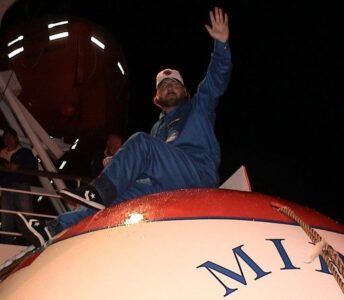Christensen recalls Titanic dive as 113th anniversary of sinking approaches

David Christensen of Amherst inside the Mir submersible which was used to reach the wreck of the doomed ocean liner, Titanic. Courtesy photo by DAVID CHRISTENSEN
AMHERST – Since its discovery in September 1985, the grave of the RMS Titanic, has been notoriously known as one of the most hostile environments on Earth; a place that less than 250 humans have ever ventured — Amherst resident David Christensen is one of them.
April 15 will mark 113 years since the doomed ocean liner slipped beneath the surface of the North Atlantic Ocean after hitting an iceberg during her maiden voyage from Southampton, England to New York City.
In 2005, Christensen, who was a Los Angeles music executive at the time, was tapped by his friend, G. Michael Harris, to manage media relations for his upcoming dive to the wreck. Harris was the founder of RMS Titanic, Inc. and owned the salvage rights to the wreck.
While prior dives had focused on a specific part of the ship, Christensen said the objective of the 2005 expedition was to film the entire wreck in high definition. Although HD technology was in its infancy at the time, Christensen still deemed the expedition a success.
“I definitely think the objective was achieved,” he said.

David Christensen of Amherst emerges from the Mir submersible after the 12-hour dive to the Titanic in 2005. Courtesy photo by DAVID CHRISTENSEN
In addition to serving as a historical record, the footage shot during the dive was used for the “Generations” documentary which focused on Harris as well as his father Michael and son Sebastian.
Christensen, owner of the Christensen Group, a Bedford-based real estate company, said it took about a day-and-a-half to reach the hallowed waters where the Titanic foundered, approximately 400 miles southeast of St. John’s, Newfoundland.
“The most moving part was being on the surface,” he said, adding that it was amazing to be in the exact same place where the world’s greatest maritime disaster unfolded.
From there, Christensen and two others climbed into the cramped confines of the Russian Mir submersible and began their two-and-a-half hour descent to the bottom.
The ship sits at a depth of 12,500 feet in a part of the ocean known as the bathypelagic zone. Down there, the pressure is a crushing 6,000 pounds per square inch — heavier than most sport utility vehicles.

David Christensen of Amherst, now the owner of the Christensen Group in Bedford, was part of the team that dove to the Titanic in 2005. Courtesy photo by DAVID CHRISTENSEN
“You’re doing a slow corkscrew all the way down,” said Christensen, adding that daylight quickly gave way to total blackness.
While falling through the water column, he said the sub pilot stopped every 30 minutes to turn on the lights and make sure everything was still running smoothly. Once Mir descended below 5,000 feet, the exterior lights revealed marine life such as viperfish, rattail fish and anglerfish — terrifying-looking creatures that almost appear to be alien.
“You’re seeing stuff that you’ve never seen, the fish don’t look the same,” said Christensen.
Once Mir finally reached the seafloor, a figure began to appear on the sub’s Sonar.
“There’s that moment, right in front of your face, there’s that steel — and that’s Titanic,” said Christensen.

The bow of the Titanic as seen in 2005 from the Mir submersible. The ship sank in April 1912, two hours and 40 minutes after striking an iceberg in the North Atlantic Ocean. Courtesy photo by DAVID CHRISTENSEN
He said the wreck is in three sections, the ship’s iconic bow, the debris field and the stern, which lies 2,000 feet from the bow.
“You’re basically in a junkyard,” he said.
Unlike the bow, the ship’s stern section has always posed a serious threat to safety. The stern still had pockets of air in it when it sank, causing it to implode and wildly spiral through the water on its way to the bottom. The result is a mangled mess of steel and cables, which could easily snag a sub.
“There was definitely a different temperament when we got to the stern,” said Christensen.
Despite protection from a maraging steel shell, Mir was by no means immune to the perils of the deep. Christensen said subs are always at risk of imploding as was evidenced by the loss of the Titan in June 2023. Subs can also get caught in debris and become unable to free themselves. If this happens, he said a sub has 24 hours of air before the crew “goes to sleep.”
Even if time allowed, rescue missions are virtually impossible as there are very few subs in the world capable of making the dive.
Looking back, Christensen said it was a privilege to be part of a Titanic expedition.
“I feel incredibly humbled and honored to be a member of such a small group of people to have witnessed such a profound piece of history up close,” he said. “At 12,500 feet below the surface, I wasn’t just looking at history, but in some way, the result of the fragility of human ambition.”
- David Christensen of Amherst inside the Mir submersible which was used to reach the wreck of the doomed ocean liner, Titanic. Courtesy photo by DAVID CHRISTENSEN
- David Christensen of Amherst emerges from the Mir submersible after the 12-hour dive to the Titanic in 2005. Courtesy photo by DAVID CHRISTENSEN
- David Christensen of Amherst, now the owner of the Christensen Group in Bedford, was part of the team that dove to the Titanic in 2005. Courtesy photo by DAVID CHRISTENSEN
- The bow of the Titanic as seen in 2005 from the Mir submersible. The ship sank in April 1912, two hours and 40 minutes after striking an iceberg in the North Atlantic Ocean. Courtesy photo by DAVID CHRISTENSEN






